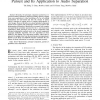Free Online Productivity Tools
i2Speak
i2Symbol
i2OCR
iTex2Img
iWeb2Print
iWeb2Shot
i2Type
iPdf2Split
iPdf2Merge
i2Bopomofo
i2Arabic
i2Style
i2Image
i2PDF
iLatex2Rtf
Sci2ools
SPL
2016
2016
Complex and Quaternionic Principal Component Pursuit and Its Application to Audio Separation
Abstract—Recently, the principal component pursuit has received increasing attention in signal processing research ranging from source separation to video surveillance. So far, all existing formulations are real-valued and lack the concept of phase, which is inherent in inputs such as complex spectrograms or color images. Thus, in this letter, we extend principal component pursuit to the complex and quaternionic cases to account for the missing phase information. Specifically, we present both complex and quaternionic proximity operators for the 1- and trace-norm regularizers. These operators can be used in conjunction with proximal minimization methods such as the inexact augmented Lagrange multiplier algorithm. The new algorithms are then applied to the singing voice separation problem, which aims to separate the singing voice from the instrumental accompaniment. Results on the iKala and MSD100 datasets confirmed the usefulness of phase information in principal component pursuit.
SPL 2016 |
| Added | 10 Apr 2016 |
| Updated | 10 Apr 2016 |
| Type | Journal |
| Year | 2016 |
| Where | SPL |
| Authors | Tak-Shing Chan, Yi-Hsuan Yang |
Comments (0)

